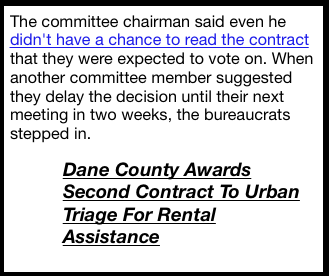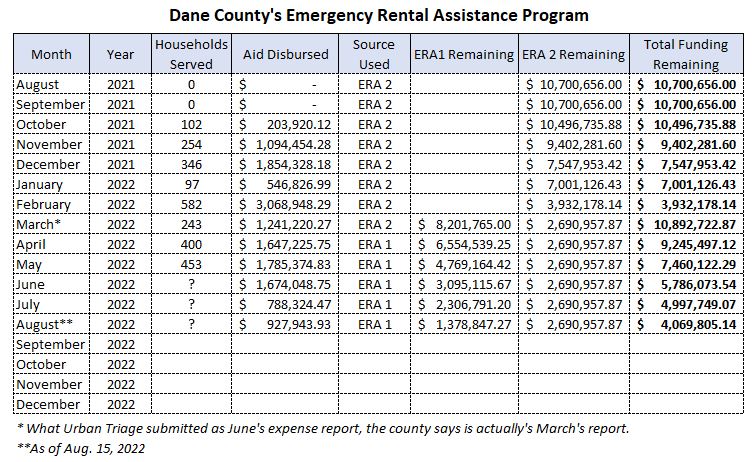
County slipped Urban Triage a second contract worth $9 million unnoticed
Bureaucrats lied to supervisors about the program’s financial situation to fast track the second contract
Urban Triage’s skimmed $2.4 million off the top in “administrative” charges
Few limits on benefits, high-income thresholds burned up funds fast
Aug. 22, 2022 | MacIver News Service
Nobody in Dane County government expected Urban Triage would rip through $10.7 million in rental assistance so fast.
The county awarded Urban Triage a $12.4 million contract to administer the emergency rental assistance program in July 2021. Urban Triage got to keep $1.7 million for administrative costs and the remaining $10.7 million was for the aid payments.

Urban Triage’s Lack of Qualifications

Urban Triage was a baffling choice. It had a history of promoting and supporting violence in the community. The organization’s founder and CEO Brandi Grayson helped support, promote, and defend the riots that devastated Madison in 2020. When State Street was looted, Grayson publicly defended them by stating, “The spirit that you see right now exploding from our youth is the warrior spirit.”
Also, Urban Triage is a racist organization that exists primarily to serve the black community, while vilifying white people. Its vision statement is “To empower and inspire breakthroughs and transformation by way of education and leadership in Black children, Black women, Black men, and Black communities.” The rental assistance program was designed to serve all people struggling because of the lockdowns, and the contract forbids discrimination based on race, ethnicity, or color.
Grayson makes frequent racist, anti-American comments like, “Within this United States of America, we got the first white supremacy state. A state in which white supremacy and capitalism are one and the same.”
Finally, Urban Triage did not have the infrastructure needed to administer the program. It took three months for Urban Triage to get up and running. Much of that time was spent trying to recruit volunteers to do the work for free on their own personal computers. Meanwhile, the CDC’s eviction moratorium expired on July 31, 2021.
County Bureaucrats Bully Supervisors
Urban Triage finally sent the first checks out in October. By March, after only four months, there was $4 million left from the original $10.7 million. Dane County bureaucrats began to panic.
When county supervisors met for their March 17, 2022 Personnel and Finance Committee Meeting, bureaucrats surprised them with a new $9 million contract for Urban Triage. The funding was from the original Covid Relief Bill (ERA 1) that that the county had received in August 2021. The County’s Human Services Department had been sitting on it ever since.
The committee chairman said even he didn’t have a chance to read the contract that they were expected to vote on. When another committee member suggested they delay the decision until their next meeting in two weeks, the bureaucrats stepped in.
“For people who could be facing eviction, every couple of weeks matter,” said one bureaucrat off camera. (It was most likely comptroller Charles Hicklin based on who was in attendance).
“They’re spending the money so fast, that that’s the reason for the late addition. They’re at a point where they need additional resources, which we have available, but we need to execute a contract change in order to keep the service flowing without interruption,” County Human Services Director Shawn Tessman said.
“Urban Triage has been disbursed all the money that we currently have available before this contract. This is the same contract we approved prior. It’s just a different source of money.”
Much of what the county bureaucrats said was not true. There was more than $2.7 million of assistance left, which would have lasted at least another month and a half. The funds were not on track to run out within two weeks.
Also, it was not the same contract. The language might be similar, but it had different terms, a different amount of funding, a different schedule, and a different contract number. The new contract was created on Jan. 21 and revised on Feb. 2. And yet, the bureaucrats waited until Mar. 17th to share it with the supervisors.
Finally, if the county had disbursed Urban Triage all the remaining funds, then it was in violation of the contract. The county was only supposed to advance Urban Triage $630,000 a month.
Regardless, the committee members relented. They voted unanimously to recommend the contract. Later that evening, the full county board of supervisors approved it. Urban Triage now has two contracts for administering rental assistance worth a combined $21.4 million. It gets to keep a total of $2.4 million.
Easy Money
It shouldn’t have been a surprise that the rental assistance money is vanishing so quickly. There is no monthly limit on assistance per household and almost no limit on what the funds could go towards.
It can go towards parking fees, storage fees, pet fees, eviction-related fees, heating bills, internet bills, water and sewer bills, trash pickup, and security deposits. It can even pay for repairs caused by the tenant through “negligence or improper use of the premises by the tenant and their guests.”
Also, you don’t have to be poor to receive assistance. Eligibility is based on the Area’s Median Income (AMI) rather than the Federal Poverty Level (FPL). To qualify, total household income had to be below 80% of the AMI for Dane County, which is set by the US Department of Housing and Urban Development (HUD). For a single-member household, that’s $55,950, which puts them squarely in the middle class. Meanwhile, the FPL annual income for a single-member household is $13,590. The program is supposed to prioritize applicants who make 50% of the AMI, which would be $36,100. However, assistance is awarded on a continual basis, which makes such prioritization difficult.
Benefit Miscalculations
The county’s estimates on assistance amounts were off. According to both of the contracts awarded to Urban Triage, each household was expected to receive an average of $3,561 in assistance. The actual average assistance per household had reached $4,901 by the end of February, which was 38% higher than expected.
The second contract that was signed a couple of weeks later kept the original estimate in place of $3,561 per household, even though it had already been proven incorrect.
Dane County’s Human Services Department told MacIver it’s not surprising that the estimates were off.
“When we set contract metrics, we base it on previous program performance data. It’s not surprising that the Dane CORE program has a higher average aid amount,” Communications Manager Tanya Buckingham said.
She said the previous programs the county used for its calculations only paid back rent, while the program Urban Triage is administering covers much more. Buckingham also suggested that raising rent could be a factor. According to HUD, rents have increased an average of 15% in Dane County over the past five years (while the program’s estimates were off by 38%).
Current Funding
As of mid-August, Urban Triage has approximately $4 million of total assistance remaining. The federal government’s deadline for disbursing those funds is Dec. 31, 2022. At the current rate of disbursement, Urban Triage will likely has exhausted all funds by the end of November. Urban Triage will have kept a total of $2,435,775 for administrative costs.





